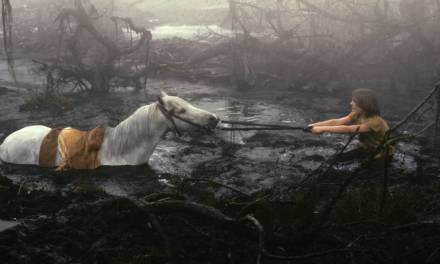Of course not! Right? Well, apparently, it may not be so cut and dry.
Thanks to the ridiculous ‘blue dress’ debacle, the internet has been full of wonderful articles on color theory and physics lately.
I stumbled across this particularly interesting one that claims that the color blue may be a relatively modern invention. At first it seems easy to dismiss as nonsense, after all, the entire sky is blue. But the article poses some interesting points, and although the color obviously existed, humans may have been completely unaware of it for centuries.
Don’t believe me? Take a look at the full article HERE, it may just change your mind.







Really great article. It's interesting that the author never mentions Lapis Lazuli – the historical pigment in Ultramarine – as a natural source of the color in nature. According to the Wikipedia entry it was commonly referred to as Sapphire and not Blue in classical times and the middle ages, so that may have been a source of confusion in historical references. From the entry:
“In late classical times and as late as the Middle Ages, lapis lazuli was often called sapphire though it had little to do with the stone today known as the blue corundum variety sapphire. In his book on stones, the Greek scientist Theophrastus described “the sapphirus, which is speckled with gold,” a description which matches lapis lazuli.
There are many references to sapphires in the Old Testament, but most scholars agree that, since sapphires were not known before the Roman Empire, they most likely are references to lapis lazuli.”
Source: http://en.wikipedia.org/wiki/Lapis_lazuli
On a side note; the perceptual flaw highlighted by the article really makes me wonder whether the same thing is going on when we look at the vastness of space and see no signs of visible life. It's remarkable to think that it's possible that you can't perceive what you don't understand. Even if it's right in front of you.
A wonderful read Dan, thank you for pointing it out!
Reminds me of the change in awareness Copernicus and Galileo help shepherd in of the Earth as a rotating and spinning body around the sun, rather than the sun moving about the earth. It's always been that way, but almost no one could 'see' it as such before the 16th Century.
I think the same applies to the notion of the Earth being round. When I see a really wide expanse, it appears that I can almost see the curvature of the Earth (which I know is an optical illusion). But I can't help but wonder “didn't man always notice this?” I suppose, the answer may be no. They weren't looking for it.
It is a strange fact that we have far, far fewer blue receptors than green or red. If all our receptors were equal, what an astonishingly blue world we might live in. So it seems we have been calibrated to see the world as we see it, in some kind of color balance.
Naturally, there would be much more blue bouncing around outside than inside. And I wonder if native tribes who spend far more time outdoors have learned or have adapted to filter out even more blue than us cave dwellers. An alternate hypothesis might be that outside dwellers may have their few blue receptors burned out by long term over-exposure to blue light. In any of these cases, we can imagine that the consequence would be increased sensitivity to non-blue colors, green and red particularly, with a special sensitivity to yellow due to the low blue reception. Which would explain why the slightly more yellow green would stand out to them quicker. (Shooting from the hip in all of these pet theories, of course.)
Biologically speaking, to have such a major advancement in structure happy across the board, species-ly, seem improbable in such a short (relatively speaking) period of time. The language problem the author is outlining seems to be more a simile problem, that the ancient writers just didn't have the words to probably describe the blue things. There is also a question of translation and language shifts over time. I personally find it hard to believe the concept that in the short history of language we've gained the ability to see blue.
I think you're jumping over the actual conclusion made in the article…while they both had no word for it and biologically could see it, the problem I inferred was that it was perception. Where do we draw the lines between one color and the next? Most people would name 7 main colors of the rainbow, but why not 2…warm and cold? Why not 10? Are purple and violet two different colors? If it was anything like the tribe mentioned in the article…they simply considered them one color (one a more purply-green and the other a yellow-green, I guess?). I'd be interested to know how the modern recognition of blue might have been helped by painters and the recognition of part of bluegreen (again making a random assumption on where they draw the line) being a primary and the other end of it being secondary. I bet its possible that drove the need for recognizing a separate color.
The color balance idea sounds quite plausible. After all, our brains filter out so many other extraneous things, why not an over predominance of blue?
Interesting for sure. Great article at the link. Why complicate things by making the sky more than the sky by calling it a blue sky? I wonder if the the same concept might exist with brown and other muted colors of the Yellow-Red family or the Yellow-Red family in general. Dirt is dirt, Why complicate by calling it brown dirt or red dirt? If there is no need for extra descriptors, then a simple declaration might do, especially in stressful Paleolithic or early Neolithic scenarios.
Michael Aviano would tell of a story that when the western value system, that had existed for a millennia previously, was introduced to Japan and eastern societies they would frequently over model the forms resulting in “dirty looking” drawings. Previously, they lived in a linear world of black, white, and red. And while they could see value they couldn't necessarily conceive of it…at first.
So, perhaps perception isn't necessarily tied to conception, until a conception is required to navigate this quirky universe of ours.
So after dark/light or white/black or whatever, the next most noted color is red, the article stated. But red is rare in the natural world most people exist in. Being unusual, it had to be named. The other colors (including the blue of the sky, the yellow of grain, the brown of dirt, etc., etc.) were taken for granted and apparently seldom names by many societies, if the article is correct.
That's my perception of this, for what it might be worth.
So after dark/light or white/black or whatever, the next most noted color is red, the article stated. But red is rare in the natural world most people exist in. Being unusual, it had to be named. The other colors (including the blue of the sky, the yellow of grain, the brown of dirt, etc., etc.) were taken for granted and apparently seldom names by many societies, if the article is correct.
That's my perception of this, for what it might be worth.
I have to disagree here. Red is one of the earliest pigments known to man, mostly because how commonly available it is… Blood, clay, iron oxide, flowers, berries, etc.
Here in the UK, of course, most people would say that the sky is grey, and the sea brown….
Dan — I'm talking colors ordinary people saw, not artist pigments. Take a step outside (if you live out in the countryside) and look for bright reds in nature. The most likely candidates are blood, spots of color on some birds and occasional sunsets. Earth reds are comparatively dull and the folks who created vocabularies millennia ago wouldn't have been hugely motivated to come up with a name for that. Bright reds are unusual, and likely deserving a name.
The frequency of reds sitting in the landscape may not be high, but I'd say that the /importance/ of reds from a survival standpoint for humans sure is. Being able to see the red of blood stand out as a sign of injury on yourself or others, sure, but also because red as a tint to skin can indicate other health conditions. More importantly though, flushed skin can help demonstrate emotion, if someone is flushed with embarrassment or anger or whatnot. So being able to read these cues is helpful to getting along. We're very socially dependent creatures, after all– it's part of how we evolved.
Surprised no one mentioned the BBC documentary about color perception. It has nothing to do with “inventing blue” as a color – it's in fact all tied in with our language.
http://www.dailymotion.com/video/xl7cgh_horizon-do-you-see-what-i-see-part-1-4_shortfilms
Watch it 🙂
I am very seventh if blue is the most important investment today, because there is no investment more important than blue investment